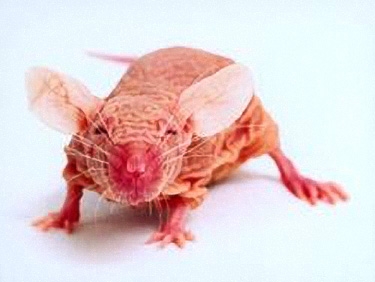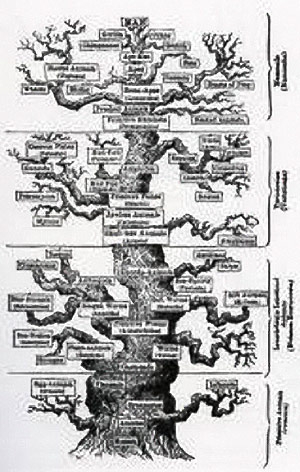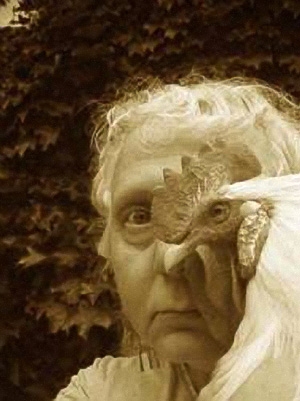Feature: Essays
We Are/Are Not Animal
- Tate Britain
- London, UK
- June 19, 2009
This talk, delivered at Tate Britain June 19, 2009 as part of the Species and Power panel moderated by Rob La Frenais at the Eye of the Storm symposium, was also presented in an earlier form at the College Art Association meeting in Los Angeles, February, 2009. That panel, moderated by Marcia Tanner, sparked an exhibition co-curated by Tyler Stallings and Rachel Mayeri, Intelligent Design: Interspecies Art, which opens at the University of California, Riverside Sweeney Art Gallery on Saturday, September 5. Links to this exhibition and related, archived exhibitions appear at the end of the text. — Ed.
Thinking along with works from a diverse group of artists, I am going to talk about one particular idea, the notion that there is a boundary between “animal” and “human,” the history of that idea in regards to gender, and why it is important for us to think about these issues now.
One of the places we can see the animal/human boundary in action is in the laboratory. This well-known portrait by Catherine Chalmers is of a mouse that has been genetically engineered for use in medical research, a practice that demonstrates that we’ve decided being human is not simply a matter of DNA. As we heard from Dr. Victor Nurcombe yesterday, a cell that is “human” can become part of a “humanized” mouse. Once that cell is part of a mouse, it no longer receives the special protections it would receive as part of a human. From one point of view, it has become a “model” — a representation — an object that is used to describe something else. We no longer think of it as an “agent,” a being that gets to make life choices. The discipline of biology has grown up with this way of thinking about life forms, which is related to the cultural metaphor that equates Nature with the Feminine.
To quickly point towards the way the gender relationships have structured biological thought, we will start with this well-known diagram of the Tree of Life, from Ernst Haeckel’s 1879 book The Evolution of Man. It conveys the exalted position of Man in early biology. Women, like animals, were consciously and unconsciously construed as “other” in narratives of “nature” that put Men on top.
Therefore, women were particularly well-placed to notice the ways in which those narratives sustain oppressive power relations inside and outside the laboratory. As women entered official biology, some of them began to ask if the attitudes towards animal life embedded in scientific culture related to gender issues. Biologists such as Lynda Birke, Donna Haraway and Ruth Hubbard raised questions about how the exclusion of women shaped biological science.
Birke has written about the progressive desensitization involved in her training as a biologist, describing the repression of feeling required for her to view animals as “models,” representations of processes, rather than agents with their own needs and desires. But, Birke writes, when her daughter walked out of biology class forever rather than kill a frog, she began to ask what the study of life would be like if it did not involve so much killing. Is it possible to imagine a biology conducted with respect for the lives of other species? Is such a biology necessary for society to achieve gender equity? Could such a biology contribute to our own survival?
These questions are often perceived as threatening, as they quickly lead to spheres beyond biological science. Every day, every one of us uses animals, for food, clothing, and other human wants. The boundary between human and animal, with all the power it gives us, is such an integral part of our daily lives that conceptualizing the world with different boundaries and power relationships is almost inconceivable. Where can we begin to imagine it?
According to Larry Carbone, who works as a veterinarian in animal laboratories, “Animal ethics requires consideration of power inequities. Alongside this…is the need to know the facts about animals: what they want, what hurts them, what causes them pleasure or distress or joy, and to recognize how those facts might differ for such widely differing animals as chimpanzees, mice, squid, and amoebas.”
Among human animals, our process of discerning what another wants, what hurts them, what brings them joy involves “communication.” Is communication the route to animal ethics? Has our culture been choosing not to listen to other species, or is such exchange impossible? What are the bounds and potentials of interspecies communication? One route along which the discussion could proceed is suggested by the British artist Mary Britton Clouse, who is active in animal rescue. Clouse images “seeing” through the eyes of the animal In the photograph Nemo Portrait, Self Portrait and in an accompanying text, which reads:
“I was born in a crowded noisy place. I was shoved in a dark box and woke up at the Dodge Nature Center starving and thirsty, surrounded by dead bodies. I grew up there and lost one eye in a fight and the other never worked too well. Winter came. Parts of my face froze and turned black and hard. Then I got sick when I couldn’t reach food and water — it was scarce, dirty and tasteless anyway and the others were always frantically fighting over it. I was grabbed and shoved in a wire cage and left in a closet. That was on February 21st. On February 27th, I was grabbed and jostled into the frigid air. I was so weak it took all I had to cry out. I guess I must have died. Here its clean, bright and warm and there are others to look after. Iím still mostly blind but I know where I am now.”
This text might be described as “anthropomorphic,” ascribing the human attributes of language and memory to a nonhuman, and as “sentimental,” “appealing to the tender emotions,” a sort of description that makes people uncomfortable in “serious” scientific and policy discussions — and often, in “serious” art discussions.
Yet we now describe animal and human bodies as intimately related. If the same basic chemistry and processes of life are at work in all living organisms, perhaps projection is a valid aid to understanding other species. We share brain structures, hormones, and other physiological components of emotion with many animals. Yet empathy exercised without knowledge has limits. Carbone gives the example that chickens appear to value the opportunity to scratch litter more than the opportunity to have larger cages — yet because humans find crowding uncomfortable and don’t mind not being allowed to scratch the ground, activism on on the behalf of chickens usually emphasizes relief from crowding.
Which brings us to the concept of “umwelt,” which originated with Jakob von Uexküll, one of the founders of ecology. Uexküll’s insight was that each animal’s reality is produced by exchange with its environment that is produced by its organs of perception. Each species, therefore, lives in its own world. Uexküll gives the example of a tick, which is blind and deaf but perceives the skin temperature typical of a warm-blooded animal with the intensity of a fire alarm.
Giorgio Agamben writes that “Where classical science saw a single world that comprised within it all living species hierarchically ordered from the most elementary forms up to the higher organism, Uexküll instead supposes an infinite variety of perceptual worlds that though they are uncommunicating and reciprocally exclusive are all equally perfect and linked together as if in a gigantic musical score…”
I will now show clips from three digital videos in which I see the artists working, in different ways, with the concept of umwelt. The first is from Safari, a seven minute video by Catherine Chalmers, the second is Deeparture, a two and a half minute piece by Mircea Cantor. [Ed. note: These clips can be viewed at the links given with the exception of Deeparture which is no longer available on the Web.]
The jungle in Safari is hand-made. To construct it, Chalmers learned, in a physical, material way, about the scale, textures, and densities of the animals’ world. And she imaged their viewpoint with her camera placement. Cantor, on the other hand, deprived the animals in Deeparture of the environment they are formed to perceive. The wholeness of being that is animal plus environment is erased. Both antelope and wolf are uneasy. They do not act as we would expect them to, they cannot “be themselves” in this blank white world.
The final clip is from a seven minute piece called Troglodyte by Desiree Holman.
In relationship to this work, Holman says “I got really interested in esthetic rapture, an idea I first encountered in reports of apes in troops dancing in front of waterfalls for what appeared to be no practical reason. Usually they display to gain status in the troop. It has been theorized that they are somehow moved by the waterfall and find pleasure in moving together, that this might be the first seeds of religion.”
In part, the significance of Troglodyte derives from Holman’s reference to a moment in our species history when what was “animal” and what was “human” were closely bound together. In the context of our discussion today, she addresses a moment when a new perceptual world — a new “umwelt” — emerged from our ancestors’ interaction with the environment. Of course, our interpretation of this past, through primatology, has been riddled with gender issues as Donna Haraway and others have pointed out, and a full discussion of the issues raised here would be lengthy. But as time is flying I will move on to two final points.
The video installation Aporia by Liselot van der Heijden is a repeated loop of a zebra at the moment of taking its last breath. I believe it confronts the viewer not only with this particular dying animal, but also as an urgent communique of our communal fear that we, as a species, are committing suicide by destroying our own umwelt, our total environment with its incredible riches of co-evolved species. The gendering of nature as “female” which authorized domination is not looking like such a good strategy.
Counterpoised to this fear is the hope that humans might be able to create a relationship with their world in which they contribute to its maintenance and even its flourishing. Feminist philosopher Chris Cuomo writes about an ethics of flourishing, that involves a “commitment to the flourishing or well-being, of individual, species, and communities…Compassionate action is, of course, crucial to an ethics of flourishing.”
I will end with the home page for the Web site of Embracing Animal, a work by Kathy High and an artist’s representation of compassion. In this piece, High, who herself suffers from an immune disorder, purchased three transgenic lab rats — animals she feared and which had been bred to develop genetic diseases similar to her own. Instead of justifying their use to cure human illnesses, High endeavored, as a symbolic action, to cure the rats. She created the best environment that she could for them, treating them with homeopathic remedies, carefully monitoring their diets, and loving them. They lived many months beyond their expected shortened life spans.
Perhaps if we humans deeply engage these questions of compassion, justice, and our world, we, too, may find ourselves some extra time.
###
Current Exhibition:
Intelligent Design: Interspecies Art, University of California, Riverside Sweeney Art Gallery
Archived Exhibitions:
Interspecies, Arts Catalyst
The Animal Gaze, London Metropolitan University
Becoming Animal, Mass MoCA
HOME PAGE IMAGE: Desiree Holman, Soothsayer (2005) from the Troglodyte series



